For years OLED TVs have delivered the best image quality available with display technology that has remained largely unchanged, but LG promised something even better for 2021. The G1 has an all-new panel not available on any other TV LG sells. The company calls it Evo and says it achieves higher brightness and improved color. My verdict? Yes, it's slightly better than before but even in a side-by-side comparison, it was difficult to tell the difference.
How it stacks up
Like
- Best picture quality we've ever tested
- Slightly brighter than previous models
- Beautiful slim design perfect for wall-mounting
Don't Like
- Expensive
- Image quality improvements over cheaper OLED TVs are minor
I set up the G1 next to the CX, the best TV I reviewed in 2020, measured both and watched a variety of TV shows, movies and games. The G1 was indeed a bit brighter than the CX but color was nearly identical, as were other aspects of picture quality like video processing and uniformity. Both looked spectacular, however, and in most material I really couldn't say one looked better than the other.
The main advantage the G1 has over the CX and pretty much every other OLED TV is its unique design. This TV is made to be wall-mounted -- quite literally; it doesn't even come with a stand! If you want to put it on a piece of furniture, as shown in the images in this review, you'll have to pay $100 extra for LG's little side legs. And that would be a shame, because something this thin should really be on a wall.
New for 2021 LG has improved its already best-in-class gaming features by adding picture modes especially for games, as well as a convenient menu that shows all gaming info and adjustments in one place. There's a new remote and a new smart TV homepage, too. The more affordable C1 shares those features with the G1, however.
At this point, the G1 is the best TV I've ever tested -- by a nose. I have yet to review its competitor from Sony, the A90J, which also promises a brighter panel, or any other high-end TVs like Samsung's Neo QLED models, so that title might not last. But for people who don't have money to burn, the extra picture quality of the G1 probably isn't worth the extra money over mainstream OLED models like the CX or C1.
Get to know the LG G1 series
- It comes in three sizes and costs a bundle: 55-inch ($2,200), 65-inch ($3,000) and 77-inch ($4,500).
- It differs from the less expensive C1 series by offering fewer sizes (the C1 has 48-inch and 82-inch options too), that Evo panel and the slimmer, wall-mount-centric Gallery design. The C1 also lacks a far-field mic for hands-free voice and a Next-Gen TV tuner, both relatively minor extras included on the G1.
- OLED display technology is fundamentally different from the LED LCD technology used in the vast majority of today's TVs, including Samsung and TCL's QLED models.
- The best LCD TVs I've reviewed so far scored a 9 in image quality, while OLEDs TVs like the G1 have scored a 10. High-end LCDs (especially with HDR) are brighter than OLEDs, but the picture quality on OLED TVs, including that of this G1, is superior overall.
- All OLED TVs are more subject to both temporary and permanent image retention, aka burn-in, than LCD TVs. We at CNET don't consider burn-in a reason for most people to avoid buying an OLED TV, however. Check out our guide to OLED burn-in for more.
Throw it at the wall
A TV doesn't get any more minimalist than this. Like many sets these days the G1 is pretty much all picture when seen from the front, but it's the side view that sets it apart. It measures just 0.8 inches deep and is designed for nearly flush wall-mounting. And as I mentioned at the top, it doesn't even come with a tabletop stand: If you want a stand mount, it will cost $100 extra.
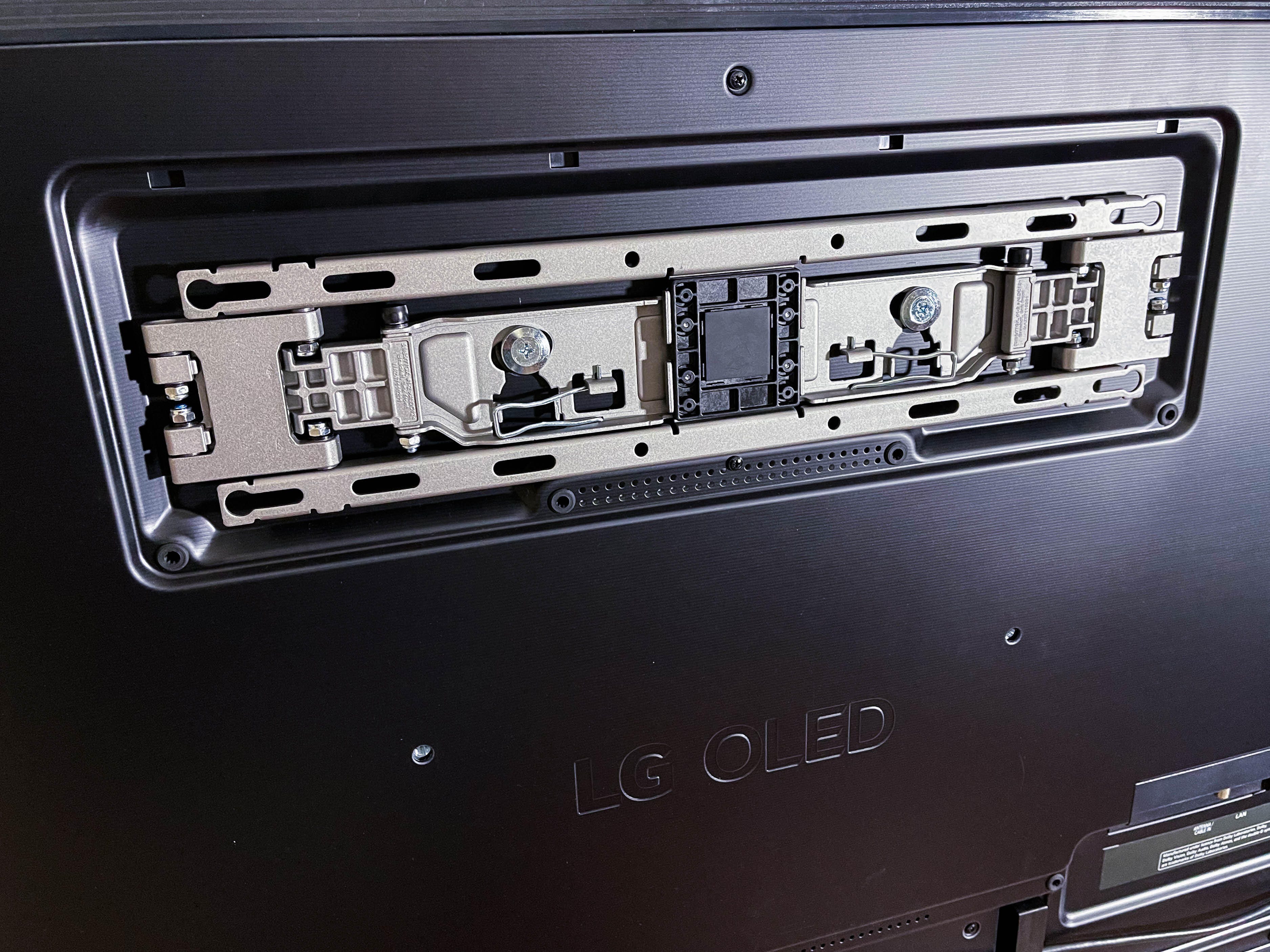
The G1 comes with a wall-mount bracket inset into a cavity on the back for a practically flush mount.
Sarah Tew/CNET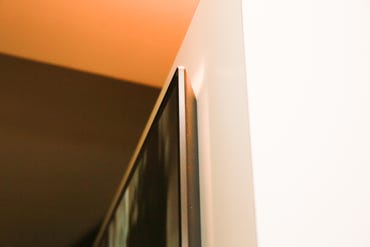
Here's what it looks like flush against the wall.
Sarah Tew/CNETThis TV's design is wasted if you don't wall-mount it. LG includes a custom bracket in the box and instructions that make it easy to slap up yourself if you're at all handy -- although I'm guessing most people in this price bracket will hire somebody to do the job. Thanks to an inset on the back of the TV the wall mount doesn't add any extra depth, allowing the G1 to hug the wall and present a very slim profile. Channels are built into the TV's back to run cables through, for a cleaner installation behind the TV. LG recommends using molding to hide cables on the wall itself. Note: I didn't mount it myself in my test basement, but I've mounted plenty of TVs before and this one seems like it would be a simple job.
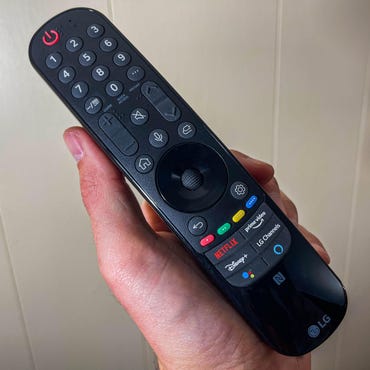
LG's redesigned remote still has lots of buttons and motion control.
Sarah Tew/CNETLG revamped the remote a bit. It kept my favorite features, namely the scroll wheel and motion-tracking, while slimming it down slightly. The biggest difference is the shortcut keys at the bottom: four for streaming services and two more for the built-in voice assistants, Google Assistant and Amazon Alexa. The former wasn't yet available on my G1 review sample, but LG says it will be soon.
The G1 is also equipped with a far-field mic (not available on the C1) so you can simply say the wake word to get the TV to respond, no remote required. It responded just like I'd expect from a smart speaker to my "Alexa" commands.
Based on my experience with the CX, both Google and Alexa can do all the usual assistant stuff, including control smart home devices, answer questions and respond via a voice coming out of the TV's speakers (yep, both voices). Basics like "What's the weather?" works as you'd expect, complete with onscreen feedback. The G1 also works with Apple's AirPlay 2 system, just like many other TVs, allowing my iPhone to share photos and video to the screen from the Photos app and mirror my Mac and phone screens.
LG's webOS menu system got a facelift for 2021 -- and I'm not a fan. Gone is the small, unobtrusive overlay at the bottom of the screen that lets you keep tabs on what you're watching. Instead there's a full-screen homepage, similar to Roku, Fire TV and Android TV. But it has fewer apps and more, well, junk. The top two-thirds of the screen are devoted to the weather, setup tips, a search window and a Trending Now section with a random collection of TV shows and movies. Below that is an app row and, further down, sections devoted to inputs and particular streaming apps. In general it feels like a hodgepodge with too much going on, and most systems are simpler and easier to grasp.
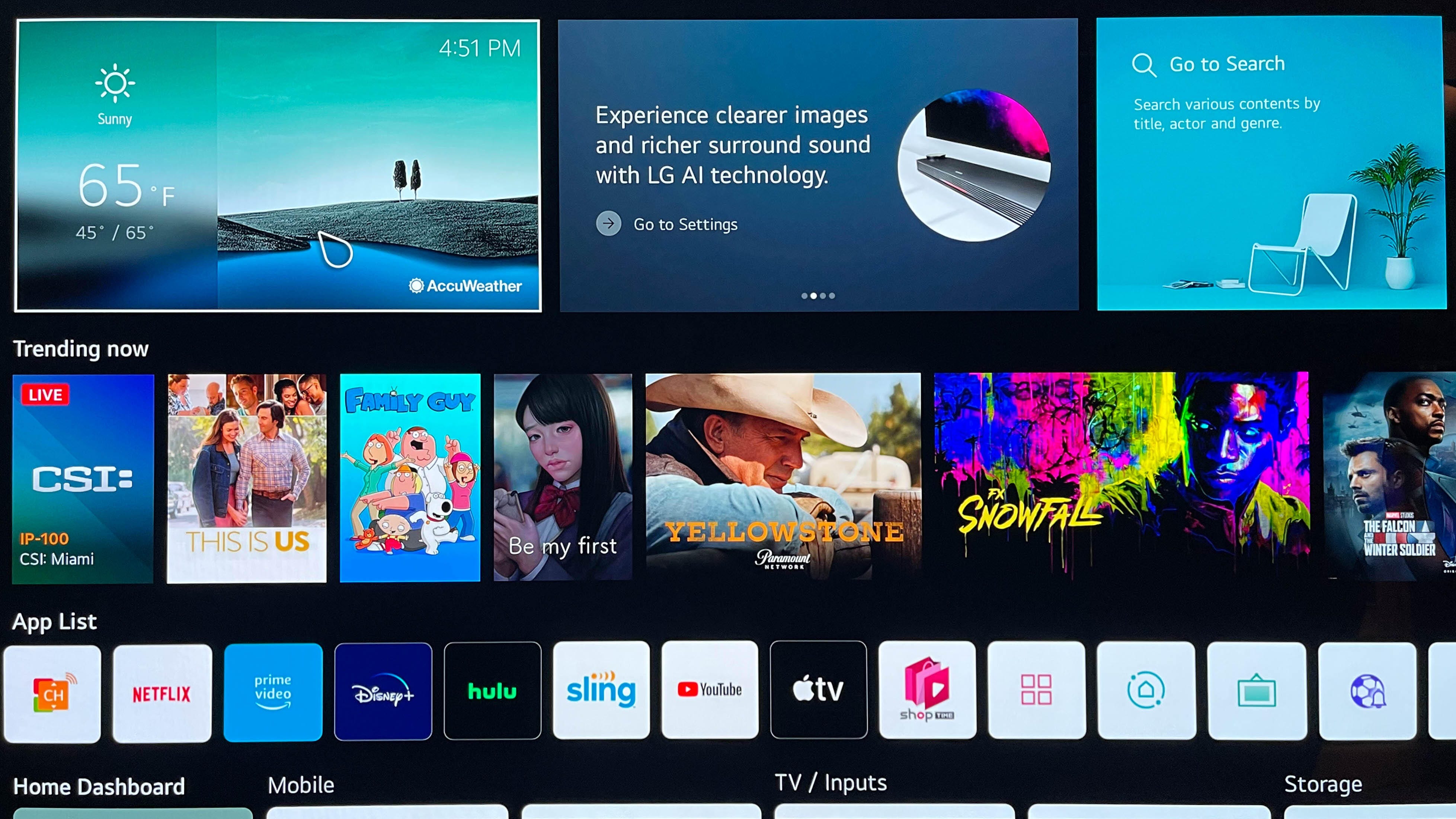
The new homepage takes up the entire screen.
Sarah Tew/CNETFeatures galore, state-of-the-art connectivity
LG says its Evo panel, available only on the G1 this year, uses a "new luminous element" for more precise lighting. The construction of the OLED pixel itself is different, with new materials for red and blue and a new green layer, all of which have narrower wavelengths compared to the pixels used on other OLED TVs.
Key TV features
| Display technology | OLED |
|---|---|
| LED backlight | N/A |
| Resolution | 4K |
| HDR compatible | HDR10 and Dolby Vision |
| Smart TV | Web OS |
| Remote | Motion |
Otherwise the G1 has the same image quality features as the C1, starting with the new Gen 4 a9 processing chip that adds scene detection and upgraded object enhancement over last year's version. Both the G1 and C1 also have a 120Hz refresh rate. The entry-level A1 OLEDs, meanwhile, have a more basic a7 processor and 60Hz refresh rate.
Just like last year, LG's OLED TVs' picture settings include a Filmmaker Mode. As promised, it turns off the soap opera effect for film-based content (yay) but so do many other modes in the G1. While plenty accurate, Filmmaker Mode is also relatively dim so I ended up using Cinema and ISF Bright for most critical viewing.
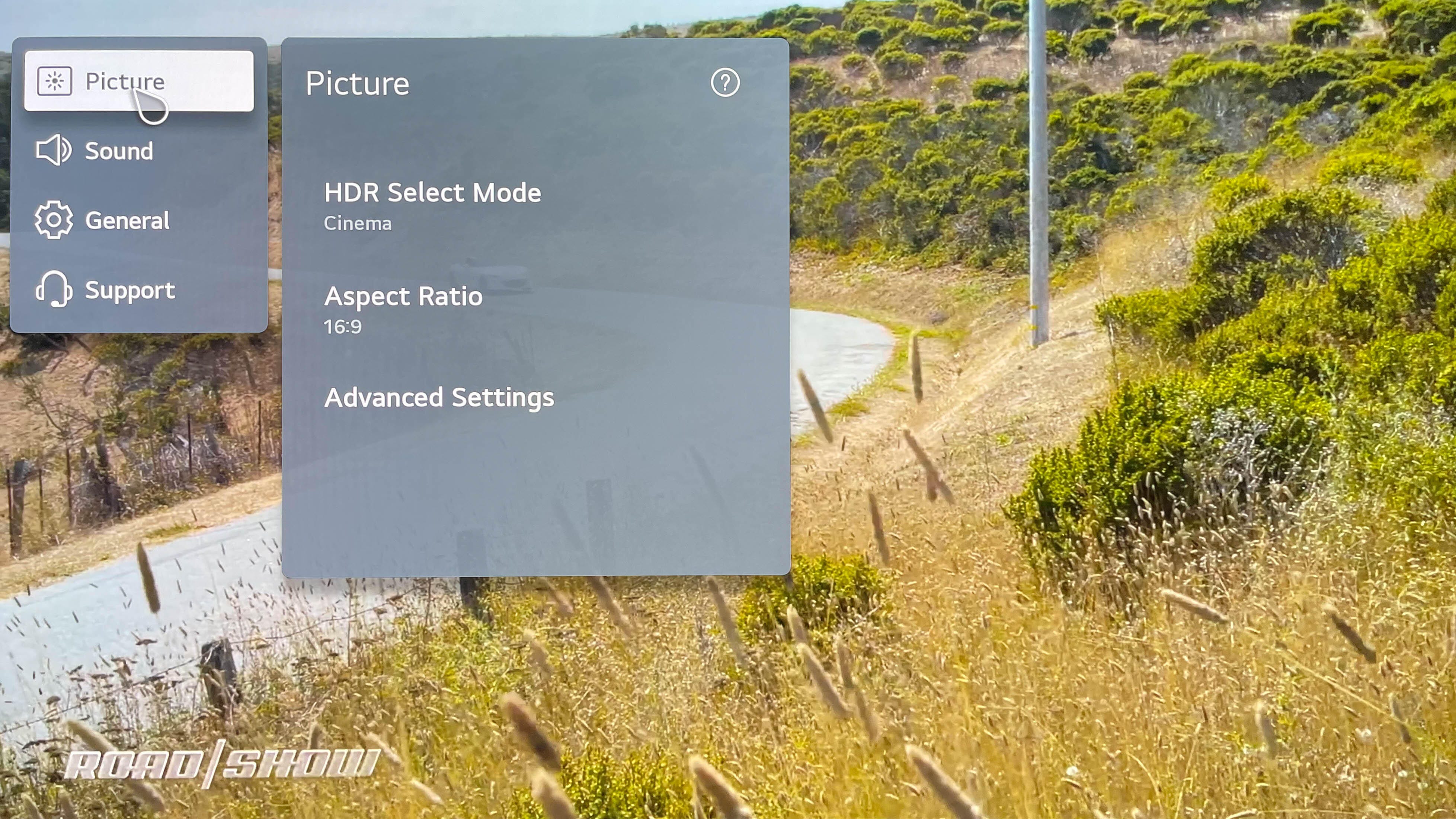
All of LG's recent OLED models (except the A1) include the latest version of the HDMI standard: 2.1. That means their HDMI ports can handle 4K at 120 frames per second and variable refresh rate (VRR, including NVIDIA G-sync and AMD FreeSync), as well as enhanced audio return channel (eARC) and automatic low latency mode (ALLM, or auto game mode). That means they can take advantage of the latest graphics features available on PlayStation 5 and Xbox Series X and S. New for 2021 is a Game Optimizer mode that puts all of the TVs' gaming-related settings in one place; see below for details.
The selection of connections is otherwise top-notch, though it no longer supports analog component video. There's also a dedicated headphone or analog audio output and another for IR blasters, which could ease some installations.
- Four HDMI inputs with HDMI 2.1, HDCP 2.2
- Three USB 2.0 ports
- Optical digital audio output
- Analog audio 3.5mm headphone output
- RF (antenna) input
- RS-232 port (minijack, for service only)
- IR blaster port (minijack)
- Ethernet (LAN) port
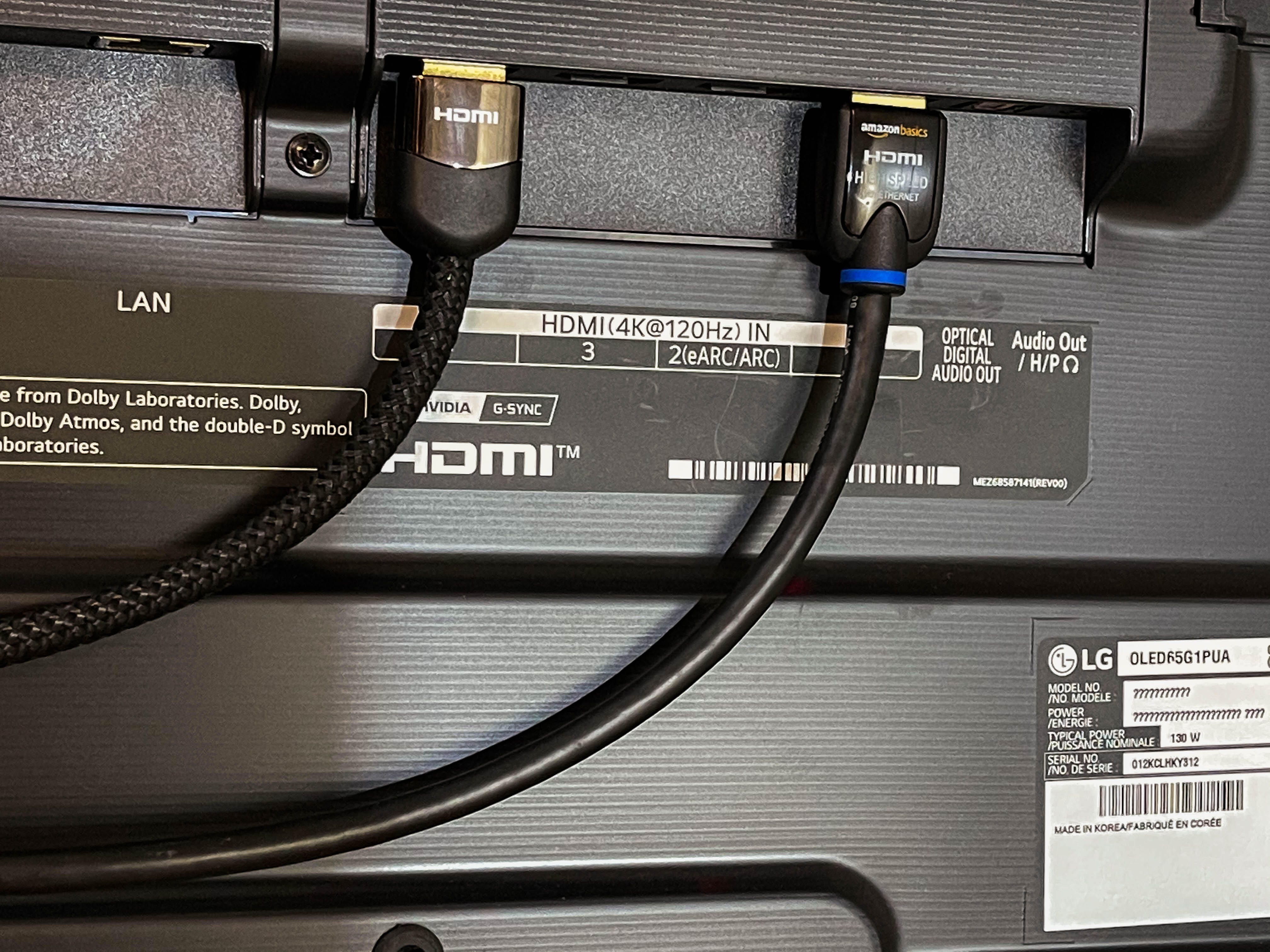
Picture quality comparisons
With its slightly better picture and a couple of other minor improvements the G1 beat the CX, my previous picture quality champ, in side-by-side comparisons. According to my measurements and eyeballs, however, the brightness difference was minor enough to be invisible at times, and just about every other aspect of picture quality was virtually identical. Both TVs looked a tad better than the less expensive Vizio OLED.
Dim lighting: The G1 performed like a champ with the lights down low -- and so did the other two OLED TVs in my comparison. I checked out The Hobbit, An Unexpected Journey on standard Blu-ray, and they all appeared more or less uniformly excellent: perfect black levels in the letterbox bars and deep shadows of Bilbo's living room during the dark Dwarven chant (36:58) and plenty of details in the shadows and clothing of Thorin and company. I couldn't see any real advantage of the G1 with this kind of theatrical situation in standard (non-HDR) material.
Bright lighting: For a TV billed by LG as an improvement in brightness, the G1's measurements didn't really stand out. Yes, it did measure brighter than last year's CX by 129 nits in the most accurate HDR modes, but that's not a huge leap and proved tough to discern in most program material. I was also surprised that the C9 I reviewed from 2019 was brighter at maximum light output and basically the same in its accurate mode. As usual, any high-end LCD is much brighter.
Light output in nits
| TV | Brightest (SDR) | Accurate color (SDR) | Brightest (HDR) | Accurate color (HDR) |
|---|---|---|---|---|
| TCL 65R635 | 1,114 | 792 | 1,292 | 1,102 |
| Sony XBR-65X900H | 841 | 673 | 989 | 795 |
| Vizio P65Q9-H1 | 768 | 629 | 1,305 | 1,084 |
| Samsung QN65Q80T | 664 | 503 | 1,243 | 672 |
| LG OLED65G1 | 377 | 334 | 769 | 763 |
| LG OLED65CX | 377 | 290 | 690 | 634 |
| LG OLED65C9 (2019) | 451 | 339 | 851 | 762 |
I asked LG's representatives whether my particular review sample's brightness was typical of other G1's and they said it was. As always, different sizes and samples can produce variations.
LG OLEDs of recent vintage have a setting called Peak Brightness that boosts the light output for SDR sources in Cinema and Expert modes. The idea is to increase contrast for brighter viewing environments while maintaining the superior color accuracy of those modes. As with most TVs, the brightest mode for HDR and SDR (Vivid on the G1) is horribly inaccurate. For the accurate color columns above on the G1, I used ISF Expert Bright (Peak Brightness: High) for SDR and Cinema mode for HDR -- I recommend G1 owners do the same to get good color in bright rooms.
All recent OLED sets are still plenty bright enough for just about any viewing environment. Yes, they do get quite a bit dimmer than LCDs when showing full-screen white -- a hockey game, for example -- but even in those situations they're hardly dim. The G1's screen preserved black levels and reduced reflections very well.
Color accuracy: LG claims better color with the new Evo panel but according to my measurements and eyeballs, it's tough to spot any difference. Color on the CX was excellent and the G1 was basically the same. An LG rep told me that the G1's white color could look more pure, like in a hockey match, but I didn't see or measure any differences in full-field white/gray (ones that weren't due to very small differences in grayscale after calibration, at least).
Watching The Hobbit was mostly the same story, although at times greens, like the grass and hillsides of the Shire (12:24), appeared a bit more greenish and less yellowish on the G1. It was a subtle difference at best, and again I didn't see or measure any difference in green test patterns, but it could be due to the new panel. Maybe.
Color on the G1 was nonetheless extremely accurate both before and after calibration. The warm tones of Bag End's interior and Bilbo's skin were inviting and intimate, and outside his hobbit hole the green of the grass and trees in the golden hour sun, and the red and blue circular doorways on Bagshot Row, looked brilliant and natural. The same could be said for the other OLED TVs, however, and none delivered significantly better color than another.
Video processing: LG goes to great lengths to tout the improvement of its processing every year, but watching various material in the best picture settings the CX and G1 looked largely identical to me.
Motion handling on the G1 is excellent and a touch better than the CX. Under TruMotion, the new Cinematic Movement setting (the default for Cinema mode) served up 24-frame cadence with a very slight hint of smoothing, improving on last year's too-smooth Cinema Clear setting while preserving 600 lines of motion resolution. 24p purists who want no smoothing at all will opt for the Off position (the default for Filmmaker mode) and suffer the low motion resolution, while tweakers will appreciate the fine granularity of the User De-Judder mode to dial in the right amount of smoothness; anything four or lower introduced some judder to my eye, conveying a sense of film rather than soap opera effect. De-Blur settings of five or higher deliver the full 600 lines of motion resolution.
User also opens up the OLED Motion Pro menu with three levels of black frame insertion that further improve motion resolution, with 800 lines in Low and a full 1200 in Med and High. The latter introduces flicker, unfortunately, and all three are a bit dimmer than Off, but if blur really bugs you then they're worth experimenting with. One improvement over last year is that engaging OLED Motion Pro no longer totally crushes shadow detail -- it's a bit worse but still very good. Still, I'd choose to leave it off and sacrifice some motion resolution for maximum light output and shadow detail.
Uniformity: Like all OLEDs I've tested the G1 was exemplary in this area, with no significant brightness or color variations across the screen and nearly perfect image quality from off-angle. Compared to the CX I did see a bit more color shift toward magenta in extreme angles with full-field mid-bright and brighter test patterns, but it disappeared when I moved closer to on-axis and never affected the image from a normal viewing angle.
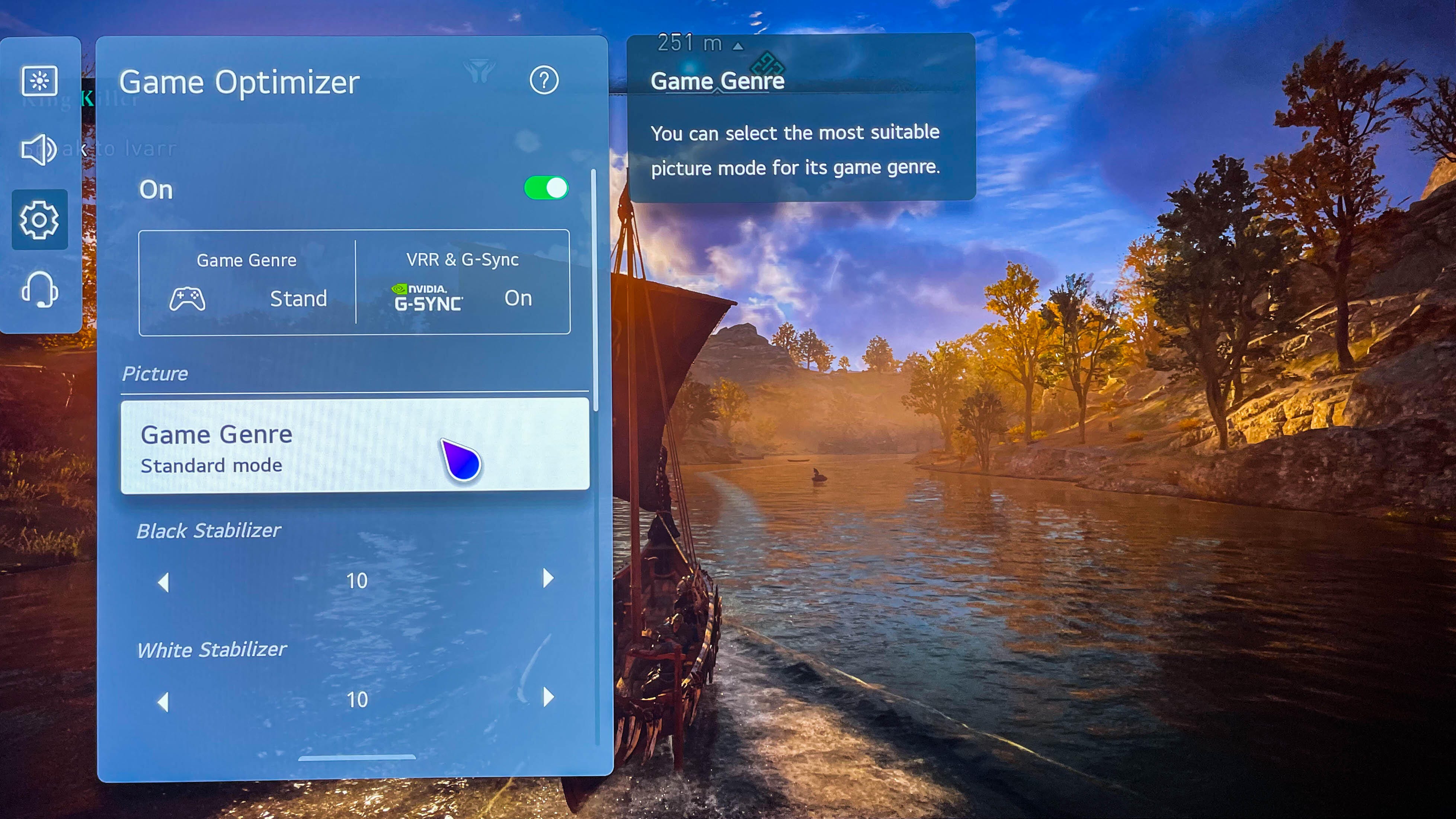
Gaming: The G1's superb image quality carries over to games, and some of its biggest 2021 features upgrades are gaming-related. The new Game Optimizer is the name of both a picture mode and a full menu system. The latter offers all-new tweaks including four game genre modes: Standard, FPS mode (said to boost shadow detail), RPG mode (to boost contrast) and RTS mode (said to enhance mid-grayscale areas). There are also sliders labeled Black Stabilizer (for adjusting dark areas) and White Stabilizer (for bright areas), as well as the OLED Motion Pro setting described above (LG says it's particularly useful for games) and the Reduce Blue light setting (said to be easier on the eyes).
I started my test in standard mode with settings at their defaults with Assassin's Creed: Valhalla at 4K/60Hz and HDR running through my distribution amp so I could compare against the other TVs. Conducting a nighttime raid, the G1 looked most similar to the CX and the Vizio in its standard mode and all three TVs looked excellent, with the G1 delivering a touch better shadow detail already. Switching to FPS upped details even further but washed out the image a bit much for this cinematic game -- although I can see it being useful in an actual FPS game if you want to reveal lurking enemies, or a very dark HDR game like Ghost of Tsushima. The RTS setting did boost midtones at the expense of some contrast, while RPG looked quite close to standard, if not as impactful to my eye. In any case it's cool having these extra adjustment options, and I liked that they each get a dedicated menu.
Next I connected my Xbox Series X directly to the G1 to test advanced video features. VRR worked as expected, significantly reducing tearing in Assassin's Creed: Valhalla, and I appreciated the prominent toggle and indicator in the Game Optimizer menu that assured me VRR was engaged. Another slider labeled Fine Tune Dark Areas is available to address the issue of VRR looking too dark. I headed deep into a crypt where VRR was crushing shadows a bit -- cranking up that setting, as well as the Black Stabilizer, helped. The flipside is that doing so spoiled black levels and washed out the look of the game, so (as a card-carrying contrast fiend) I'd avoid using it unless it really hurts your gameplay.
I also tried 4K/120Hz on Gears 5 and Star Wars: Squadrons, but the extra smoothness and framerate were difficult to discern in most cases. I appreciate that some games, like Ori and the Will of the Wisps, showed a splash screen indicating that 120fps was active, but most did not. I looked for confirmation in LG's display menu but, unfortunately, it doesn't have any. Samsung's new 2021 Game Bar, on the other hand, does indicate 120fps.
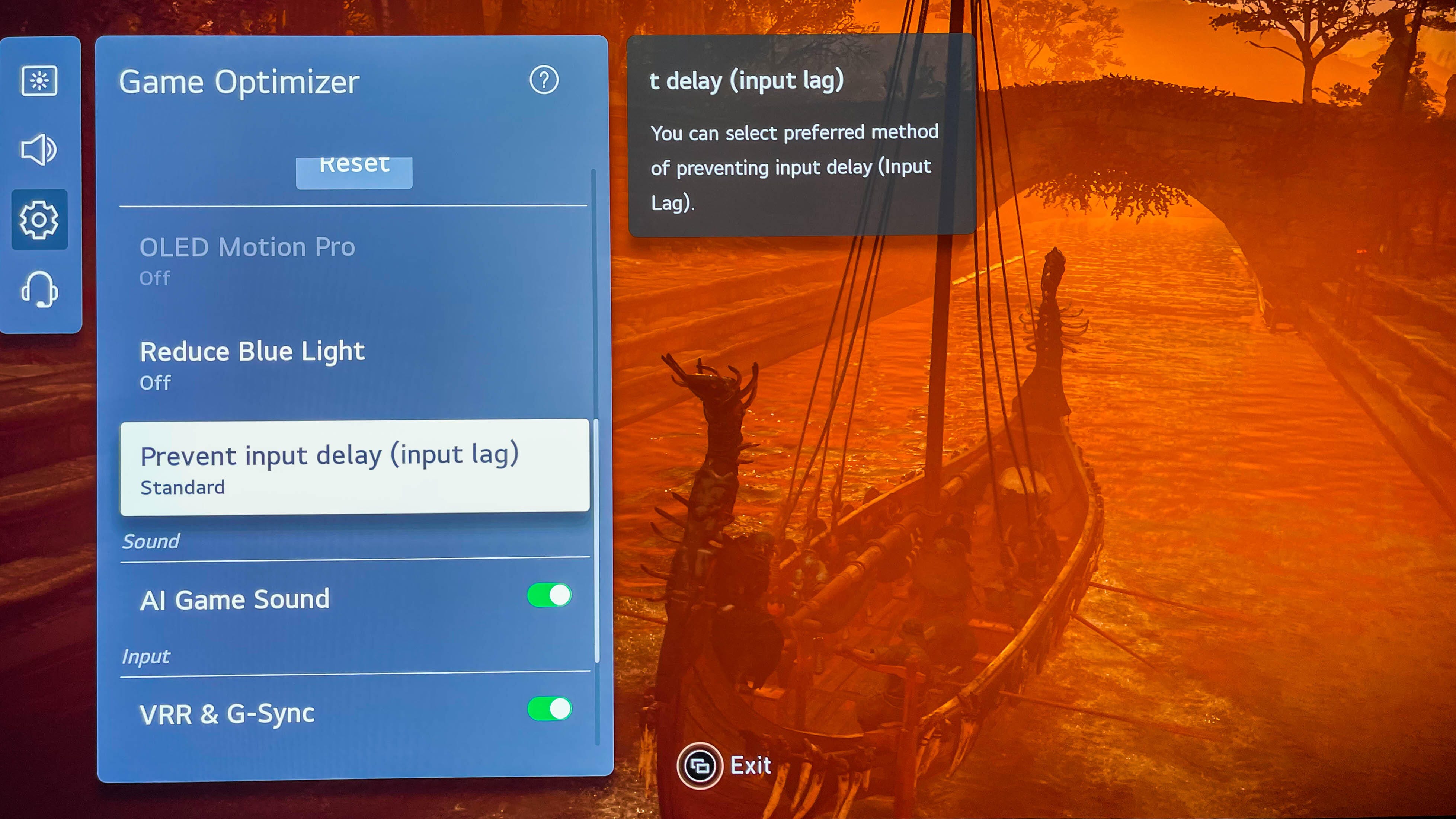
Buried within Game Optimizer is another setting labeled "Reduce input delay (input lag)" with two options, Standard and Boost. The former, which is the default for any game, serves up an excellent lag number similar to past LG OLED models: just 13.1ms for both 1080p and 4K HDR sources. Engaging Boost cuts lag even further, to just under 10ms for both. The catch is that Boost is only available for 60Hz sources, so you can't use it with 120Hz games or VRR. And no, I don't think many humans would notice the extra 3ms of lag.
HDR and 4K video: It's with HDR that you'd expect the G1's brightness advantage to be most visible, but watching the 4K Blu-ray version of The Hobbit, differences were again very slight. Highlights like the sky behind the elven king as he turns away from Thorin (7:59) or the window in Bilbo's study (9:06) measured slightly brighter on the G1 than on the CX according to my light meter but without measuring it was tough to see the difference by eye, even when compared side by side. Highlights on the Vizio appeared visibly dimmer than either one, for less HDR pop, but the differences were much narrower between the two LGs.
Color was likewise pretty much equally spectacular on the LGs and a step behind on the Vizio, which looked a bit duller in Bilbo's garden and the blue sky for example (13:25). Any color improvement afforded by the G1's new panel tech over the CX was less visible with HDR than with SDR.
I also checked out some of the most revealing HDR content around: the montage of images from the Spears and Munsil 4K HDR benchmark. Again the G1 was superb and better by a slight margin than the CX, but the G1 failed to really distance itself. Most scenes looked very similar between all three, from the crashing waves to the sunsets to the flowers to the objects on black backgrounds, and in most cases when I saw a difference it was the Vizio lagging a bit behind the other two. Spot measurements revealed mildly brighter highlights on the G1 but I couldn't tell the difference without measuring.
The benchmark also has a 4,000 nit montage to test content mastered at that level and; again, both LGs looked very similar. They outclassed the Vizio, which looked somewhat flat in some scenes in comparison.
Picture settings, HDR notes and charts
CNET is no longer publishing advanced picture settings for any TVs we review. Instead, we'll give more general recommendations to get the best picture without listing the detailed white balance or color management system (CMS) settings we may have used to calibrate the TV. As always, the settings provided are a guidepost, and if you want the most accurate picture you should get a professional calibration.
Before my calibration for this review the Cinema and preset was the most accurate, excellent in terms of grayscale and gamma with just a slight reddish cast (but still within my error target of delta 3). Since I now target a 2.2 gamma for my reviews dark rooms it was closer than ISF Expert Dark or the new Filmmaker modes, which both target gamma 2.4/BT 1886. ISF Bright was basically identical to Cinema, but I reserved that for brighter rooms.
For my calibration I tweaked the two-point grayscale to remove the red cast, reduced light output to my target of 137 nits and increased brightness two pips to help with shadow detail (while still keeping perfect black levels), but otherwise I left well enough alone. The grayscale and color were already so accurate on my LG-provided review sample that I didn't need to touch the multipoint system or the color management system.
SDR dark room settings:
Picture menu:
- Select Mode: Cinema (User)
- Aspect Ratio Settings: 16:9 (Just Scan: On)
Additional Settings menu:
Brightness submenu:
- OLED Pixel Brightness: 48
- Contrast: 85
- Screen Brightness: 52
- Auto Dynamic Contrast: Off
- Peak Brightness: Off
- Gamma (Adjust Brightness): 2.2
- Black Level: Auto
- Motion Eye Care: Off
Color submenu:
- Color Depth: 50
- Tint: 0
- Color Gamut: Auto Detect
- Fine Tune menu:
- Color Upgrade: Off (no other adjustments)
- White Balance menu:
- Color Temperature: Warm 49 (no other adjustments)
Clarity submenu:
- Sharpness: 0
- Color: 50
- Tint: 0
- Super Resolution: Off
- Noise Reduction, MPEG Noise Reduction: Off [for low-quality sources, some users may prefer to enable noise reduction]
- Smooth gradation: Off [for low-quality sources, some users may prefer to enable]
- Cinema Screen: On [may be grayed out depending on source]
- TruMotion: Cinematic Movement
- Reduce Blue Light: Off
SDR bright room setting [all default except for below]:
- Picture Mode Settings: ISF Bright Room
- Brightness menu:
- OLED light: 100
- Peak Brightness: High
HDR Notes: HDR Cinema and Filmmaker mode were very similar, following the electro-optical transfer function -- how the TV converts data to a specific brightness -- quite closely and better than Cinema Home, but Cinema was about 70 nits brighter so it's my favorite of the three. Game Optimizer is best for gaming thanks to its processing but quite blue; for the best color accuracy for gaming you should adjust the color temperature control (Color > White Balance > Color temperatureW45).
Color checker was slightly more accurate than on the CX from last year but not great, and HDR Color Checker was worse. As usual with OLED the set covered P3 HDR gamut very well. The G1 measured brighter than the CX or the B9 from 2019, but the C9 from 2019 actually measured brighter in its least accurate and basically the same in its most-accurate settings. Once again the TV automatically detected and engaged the "HDMI Ultra HD Deep Color" setting designed for HDR sources.
TV software/firmware version tested: 3.10.29
Geek box
| Test | Result | Score |
|---|---|---|
| Black luminance (0%) | 0.000 | Good |
| Peak white luminance (SDR) | 377 | Average |
| Avg. gamma (10-100%) | 2.18 | Good |
| Avg. grayscale error (10-100%) | 0.40 | Good |
| Dark gray error (30%) | 0.42 | Good |
| Bright gray error (80%) | 0.33 | Good |
| Avg. color checker error | 0.80 | Good |
| Avg. saturation sweeps error | 0.79 | Good |
| Avg. color error | 0.94 | Good |
| Red error | 2.22 | Good |
| Green error | 0.64 | Good |
| Blue error | 0.46 | Good |
| Cyan error | 0.97 | Good |
| Magenta error | 0.98 | Good |
| Yellow error | 0.36 | Good |
| 1080p/24 Cadence (IAL) | Pass | Good |
| Motion resolution (max) | 1200 | Good |
| Motion resolution (dejudder off) | 600 | Average |
| Input lag (Game mode) | 13.10 | Good |
| HDR10 | ||
| Black luminance (0%) | 0.000 | Good |
| Peak white luminance (10% win) | 769 | Average |
| Gamut % UHDA/P3 (CIE 1976) | 98.91 | Good |
| ColorMatch HDR error | 5.25 | Poor |
| Avg. color checker error | 3.29 | Average |
| Input lag (Game mode, 4K HDR) | 13.10 | Good |
LG G1 OLED TV CNET review c... by David Katzmaier
Portrait Displays Calman calibration software was used in this review.
The Link LonkApril 16, 2021 at 06:00PM
https://ift.tt/3sm8IJZ
LG G1 OLED TV review: Sets the picture quality bar just a bit higher - CNET
https://ift.tt/3eaxdmA
LG

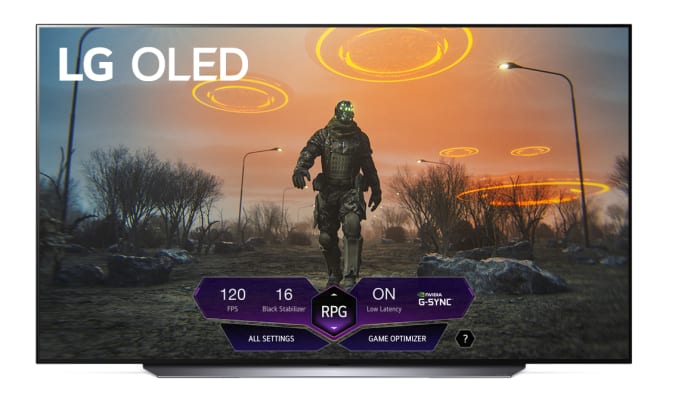
No comments:
Post a Comment